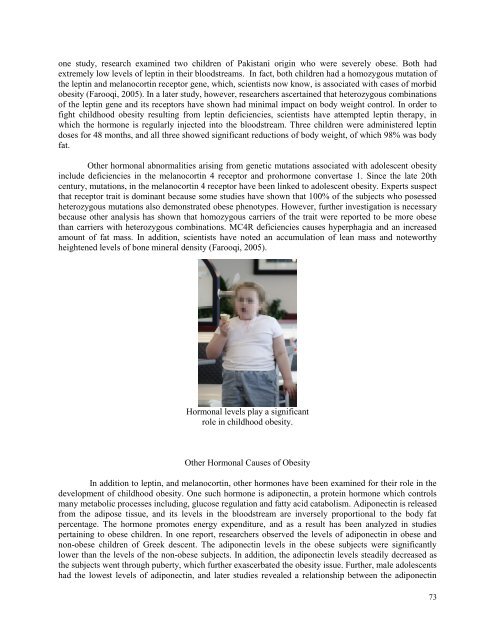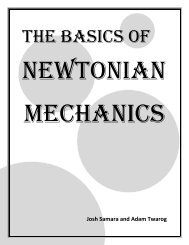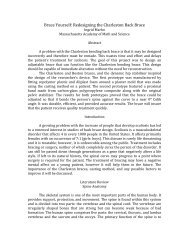Got Food? - the Scientia Review
Got Food? - the Scientia Review
Got Food? - the Scientia Review
Create successful ePaper yourself
Turn your PDF publications into a flip-book with our unique Google optimized e-Paper software.
one study, research examined two children of Pakistani origin who were severely obese. Both had<br />
extremely low levels of leptin in <strong>the</strong>ir bloodstreams. In fact, both children had a homozygous mutation of<br />
<strong>the</strong> leptin and melanocortin receptor gene, which, scientists now know, is associated with cases of morbid<br />
obesity (Farooqi, 2005). In a later study, however, researchers ascertained that heterozygous combinations<br />
of <strong>the</strong> leptin gene and its receptors have shown had minimal impact on body weight control. In order to<br />
fight childhood obesity resulting from leptin deficiencies, scientists have attempted leptin <strong>the</strong>rapy, in<br />
which <strong>the</strong> hormone is regularly injected into <strong>the</strong> bloodstream. Three children were administered leptin<br />
doses for 48 months, and all three showed significant reductions of body weight, of which 98% was body<br />
fat.<br />
O<strong>the</strong>r hormonal abnormalities arising from genetic mutations associated with adolescent obesity<br />
include deficiencies in <strong>the</strong> melanocortin 4 receptor and prohormone convertase 1. Since <strong>the</strong> late 20th<br />
century, mutations, in <strong>the</strong> melanocortin 4 receptor have been linked to adolescent obesity. Experts suspect<br />
that receptor trait is dominant because some studies have shown that 100% of <strong>the</strong> subjects who posessed<br />
heterozygous mutations also demonstrated obese phenotypes. However, fur<strong>the</strong>r investigation is necessary<br />
because o<strong>the</strong>r analysis has shown that homozygous carriers of <strong>the</strong> trait were reported to be more obese<br />
than carriers with heterozygous combinations. MC4R deficiencies causes hyperphagia and an increased<br />
amount of fat mass. In addition, scientists have noted an accumulation of lean mass and noteworthy<br />
heightened levels of bone mineral density (Farooqi, 2005).<br />
Hormonal levels play a significant<br />
role in childhood obesity.<br />
O<strong>the</strong>r Hormonal Causes of Obesity<br />
In addition to leptin, and melanocortin, o<strong>the</strong>r hormones have been examined for <strong>the</strong>ir role in <strong>the</strong><br />
development of childhood obesity. One such hormone is adiponectin, a protein hormone which controls<br />
many metabolic processes including, glucose regulation and fatty acid catabolism. Adiponectin is released<br />
from <strong>the</strong> adipose tissue, and its levels in <strong>the</strong> bloodstream are inversely proportional to <strong>the</strong> body fat<br />
percentage. The hormone promotes energy expenditure, and as a result has been analyzed in studies<br />
pertaining to obese children. In one report, researchers observed <strong>the</strong> levels of adiponectin in obese and<br />
non-obese children of Greek descent. The adiponectin levels in <strong>the</strong> obese subjects were significantly<br />
lower than <strong>the</strong> levels of <strong>the</strong> non-obese subjects. In addition, <strong>the</strong> adiponectin levels steadily decreased as<br />
<strong>the</strong> subjects went through puberty, which fur<strong>the</strong>r exascerbated <strong>the</strong> obesity issue. Fur<strong>the</strong>r, male adolescents<br />
had <strong>the</strong> lowest levels of adiponectin, and later studies revealed a relationship between <strong>the</strong> adiponectin<br />
73
















